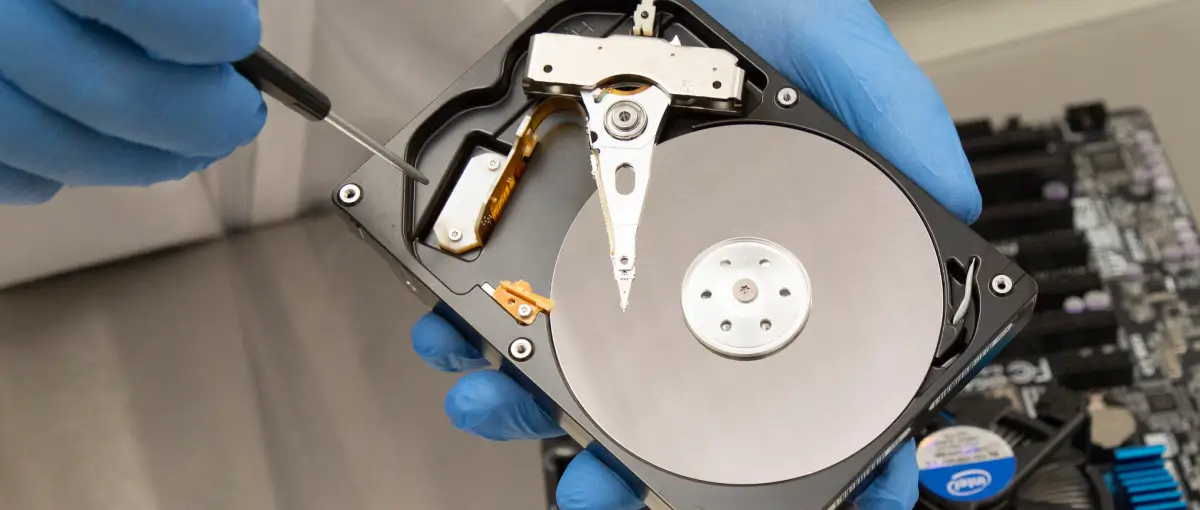Data is the foundation of our personal and professional lives. Whether it is priceless photos or videos, critical documents, or valuable research, the data stored on hard disk drives (HDDs) is often irreplaceable. However, hard drives are not immune to failure, and knowing how to navigate the situation is crucial. The experts at Secure Data Recovery explain how to recover data and back up a hard drive.
Key Takeaways:
- Data loss can result from physical damage, logical errors, mechanical issues, data erasure, malware, and more.
- Before beginning data recovery, you’ll need to understand what caused data loss.
- Choose a backup plan that makes sense for you.
Common Data Loss Scenarios for Hard Drives
Despite the impressive science behind hard drives, data loss can happen to anyone for any number of reasons, ranging from failed hardware to human error. Here are some of the most common data loss scenarios for hard drives:
Physical damage: Drops, impacts, and exposure to dust or moisture can damage internal components and cause the device to stop working.
Mechanical failure: There are dozens of moving parts inside a hard drive, including read/write heads and motors that facilitate normal operations. Without these mechanical components, users cannot access or save data.
Bad sectors: Defects on the surface of the hard drive’s magnetic platters can make data storage and retrieval unreliable.
File corruption: Corruption can occur due to system crashes, software errors, and hardware issues. Users might be unable to open files once corrupted, and contents might be missing, rendering the data unusable.
Virus and malware attacks: Malicious software can infiltrate systems and corrupt or encrypt files. In cases of malware, cybercriminals will often demand a ransom to release the data.
Accidental deletion or formatting: Accidentally deleting or formatting data is more common than most assume and usually creates a sense of urgency to restore these files.
Installation or partitioning errors: Mistakes made while installing an operating system or partitioning a hard drive can disrupt how the device stores and accesses data.
Firmware and driver problems: Flawed firmware and outdated drivers can lead to a malfunctioning hard disk and data loss.
Faulty software updates: Sometimes, software updates introduce bugs or glitches that cause hard drives to fail and leave users with inaccessible data.
Power fluctuations: Sudden power surges and outages can interrupt ongoing read/write processes and result in data loss.
Natural disasters: Fires, floods, earthquakes, and other natural disasters can damage the hard drive’s platters.
How To Recover Data From a Hard Drive
It is easy to panic when faced with data loss. However, taking specific steps after hard drive failure improves the chances of successful data recovery. The techniques outlined below can often regain deleted or lost data.
1. Understand the Data Loss Scenario
Before acting, consider potential data loss scenarios. Some cases, such as accidental deletion, are straightforward. Others might need a comprehensive media evaluation to diagnose failures. With a better understanding of the data loss scenario, users can proceed with an approach that maximizes the likelihood of recovering important files.
2. Stop Using the Affected Hard Drive
A user’s first actions can often determine the success of data recovery efforts. Stop using the affected hard drive upon noticing data loss. Continued usage could worsen physical damage and mechanical failure or overwrite the remaining data on the storage medium, reducing the odds of a complete recovery.
3. Restoring Deleted Files With Recycle Bin or Trash
The Recycle Bin for Windows computers and Trash for Macs serve as a safety net for deleted data. Recycle Bin and Trash stores recently deleted data and allows users to restore files.
Deleted data stays in the Recycle Bin until the utility runs out of space on Windows 10 and 11 unless the user sets a limit. Once full, Recycle Bin permanently deletes the oldest files first. On the other hand, Trash on macOS comes with an auto-empty feature that removes deleted files after 30 days, though users can adjust these settings.
Both utilities give people the opportunity to reverse data loss caused by accidental deletion.
To restore deleted files in the Recycle Bin (Windows) to their original location:
- Open Recycle Bin.
- Find the relevant file(s).
- Right-click on it.
- Select Restore.
To restore deleted files in Trash (Mac) to their original location:
- Open Trash.
- Find the relevant file(s).
- Right-click on it.
- Select Put Back.
If caught soon, undeleting files is an excellent option for recovering data.
4. Restoring Lost Data With File History or Time Machine
Users can also restore lost files with their operating system’s backup tool in different data loss scenarios. For Windows, that is File History. On Mac, that is Time Machine.
Regardless of the specific tool, backups duplicate stored data. With backups, users can avoid data loss by reverting to recent or previous versions of files. Users must have created an initial backup with File History or Time Machine for these options to apply.
To restore lost data with File History on Windows 10:
- Enter Restore Files in the Windows taskbar.
- Select Restore your files with File History.
- Find the relevant version.
- Select Restore to return it to the original location. To save it in a different location, right-click the version, select Restore and Restore to, then choose the desired destination.
To restore lost data with File History on Windows 11:
- Enter Control Panel in the Windows taskbar.
- Enter File History in the Control Panel’s search bar.
- Click File History.
- Select Restore personal files in the sidebar.
- Find the relevant version.
- Click the green Restore button to return the files to the original location.
To restore lost data with Time Machine on macOS:
- Ensure that Time Machine is enabled on Mac.
- Click the Apple menu.
- Click System Preferences.
- Click Time Machine.
- Find the relevant version on the right side of the screen.
- Find the file or folder.
- Click Restore.
Backups are a convenient, effective method for recovering data.
5. Restore Lost Data With Cloud Services
Cloud storage services have become more prevalent over the past decade. These services allow users to save data to a remote server and access their files on numerous devices. Having instant access to valuable data across desktops, laptops, and mobile devices makes cloud storage a popular backup option for users.
However, given the growth of the cloud, users must choose the file-sharing service that fits their needs. The steps for restoring lost data differ on Dropbox, Google Drive, iCloud, and OneDrive, so follow each service’s instructions.
6. Restore Lost Data With Built-In Features
Some applications also have built-in features to restore lost data. For example, Google Photos allows users to back up, synchronize, and restore deleted images and videos within its platform. Check the application’s capabilities before proceeding with more complex data recovery efforts.
7. Data Recovery Software for Windows
If the window for restoration closes, data recovery software is an alternative for users who need to retrieve lost files from a hard drive. These tools scan the hard drive for traces of data that still resides in unallocated space. Unallocated space refers to stored data that the file system marked for overwriting. The software can locate signatures on the disk and reconstruct the files.
However, hard drive recovery software cannot extract files once overwritten. For that reason, users should not install data recovery software on the hard drive with missing files. Doing so could jeopardize stored data.
Confirm that the data recovery software is reputable before downloading.
Secure Data Recovery offers SecureRecovery for Windows. SecureRecovery is proprietary software that addresses data loss scenarios involving logical issues. Before scanning, SecureRecovery analyzes the hard drive’s condition and informs users whether running the software is safe. After selecting a quick search or a deep scan, SecureRecovery provides a free preview of recoverable files. That way, users understand what data can be retrieved. With a full license, users can recover an unlimited amount of data. There are no forced upgrades or restrictions.
8. Data Recovery Software for Mac
While modern Macs have solid-state drives (SSDs), some legacy models run on hard drives. Considering the differences between recovering data on an HDD and SSD, users must determine the storage device in their computer and find software compatible with their macOS version.
Mac applications like Disk Utility and First Aid can sometimes recover data from hard drives. Once Disk Utility diagnoses the hard drive, First Aid attempts to repair file system errors.
If these tools do not recover files, users can try data recovery software for Mac next.
9. Professional Data Recovery Services
Despite improvements in commercial software, a professional data recovery service remains the most effective, reliable method for retrieving essential files. Hard drive recovery and external hard drive data recovery can be difficult. Professional services have the expertise to deliver solutions in the most complicated cases because they have experienced engineers who have encountered every failure scenario and a collection of specialized data recovery tools and techniques. That includes cases involving severe physical damage or mechanical failures, such as platter degradation and head crashes. No software can recover data in these situations.
At Secure Data Recovery, our team handles every aspect of the recovery process to ensure you get your data back. That means providing a free hard drive evaluation, developing a custom plan for each case, offering a no-obligation quote, and performing the recovery in a state-of-the-art Class 10 ISO 4 cleanroom that prevents further media damage.
Learn why choosing professional data recovery services could be the difference between recovering valuable files and permanent data loss.
How To Back Up Your Hard Drive
The best time to back up a hard drive is before data loss occurs. Proactive data management can save plenty of headaches and time. Robust backups protect important data from being compromised in the event of hard drive failure, ransomware attacks, natural disasters, or theft.
Implementing the following strategies could preserve data and reduce downtime even when disaster strikes.
What Makes a Good Backup?
Building backups requires users to understand several concepts and the unique demands of their situation.
First, users must know what critical data needs to be backed up and how to accomplish that. Most experts recommend the 3-2-1 Rule to organizations and individuals: Storing three separate copies of data on two external storage devices or services with one off-site backup.
The 3-2-1 Rule creates redundancy and diversity in a backup strategy.
Redundancy refers to the practice of having multiple copies of data. Having redundant data ensures that users are not reliant on a single source or location. If a backup becomes corrupted or inaccessible, users can still restore one of the other copies.
Diversity means storing data on different storage devices and keeping one of the backups at a separate location. Diversity mitigates the risk of data loss by ensuring that one point of failure does not compromise every file. In most circumstances, that involves a combination of local backups (external hard drives) and off-site storage (cloud services).
Redundancy and diversity are crucial elements of a resilient backup strategy.
External Hard Drives and Solid-State Drives as Local Backups
Deploying external HDDs and SSDs as local backups can be central to a strong strategy. Local backups could also be flash drives or SD cards. However, choosing a suitable external device is pivotal. An external hard disk offers greater storage capacities than its SSD counterpart. An external solid-state drive provides more performance but comes with higher costs per gigabyte.
The process of backing up is straightforward, regardless of the external drive. Here is a generic guide for making backups:
- Connect the external drive to the computer.
- Launch the operating system’s backup tool or third-party software.
- Select files, folders, or an entire disk to back up.
- Determine a daily, weekly, or monthly backup schedule depending on preferences and requirements.
- Automate the backup process to minimize the potential impact of human error.
Cloud Backup Services
Subscribers to a cloud backup service can store files on a remote server and access their data on any device with an internet connection.
In addition, cloud backups enhance security, provide consistent data protection, and afford users more freedom to automate the process. Unlike cloud storage, which synchronizes files across several devices, a backup service operates through an application or client program. Most cloud backup software runs in the background, duplicating data based on the configuration, encrypting files before transmission, and then storing them on an off-site server.
The primary benefits of a cloud backup are the convenience of accessing files from any device or location and protection against data loss from natural disasters or theft.
To back up data to the cloud:
- Create an account with the chosen cloud backup service.
- Install the service’s desktop and mobile applications to synchronize data between devices.
- Select files, folders, or entire disks to back up.
- Verify that the files are accessible through the cloud backup’s application or website.
Hybrid Backup Solutions
Hybrid backups integrate multiple backup methods into a complementary approach. A hybrid solution allows users to leverage the advantages of local and cloud backups while limiting their disadvantages. As a result, hybrid backups often lead to the best balance of accessibility, redundancy, and diversity.
Here are some considerations for building hybrid backups:
Data assessment. Identify the invaluable data that must be accessible and redundant.
Twofold protection. Local backups are immediately available and offer users direct control over critical files. Cloud backups make data redundant and provide disaster recovery capabilities after localized failures.
Automated processes. Most backup software empowers users to automate their routines and diminish the possibility of human error. The software synchronizes new or modified data to a server.
Implementing a hybrid backup strategy and following the 3-2-1 Rule contributes to an organization’s data protection.
Recovering Data From Hard Drives
Safeguarding data is vital in a digital world. It is why we emphasize the importance of backups and other preventative measures. Still, hard drive failure happens, and sometimes organizations and individuals cannot restore backups, leaving them to grapple with the devastating consequences of data loss.
Secure Data Recovery can help you in those situations.
We have the expertise and experience to recover data after catastrophic failure. Since 2007, we have encountered every data loss scenario regardless of manufacturer, model, operating system, and file type. In that time, we have resolved over 100,000 cases and returned billions of files to customers, even when other data recovery services declared the hard drive unrecoverable.
Despite taking the most challenging cases, our team has maintained a 96% success rate. We also offer free consultations and a “No Data, No Recovery Fee” guarantee. We return your data, or you pay nothing.
Call our award-winning representatives at 800-388-1266 to start the recovery process and stop sudden data loss from becoming permanent.






